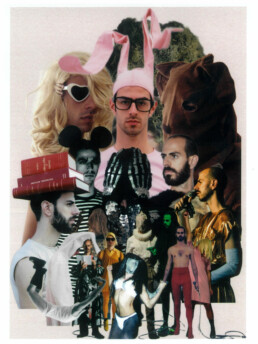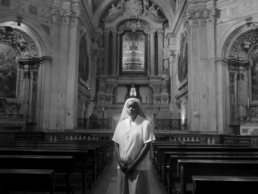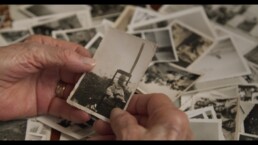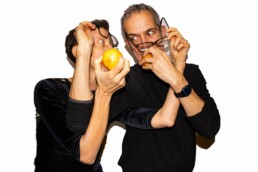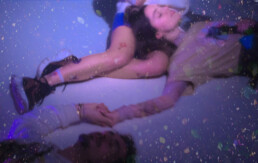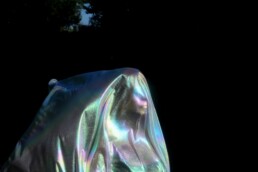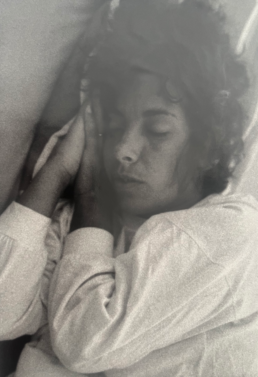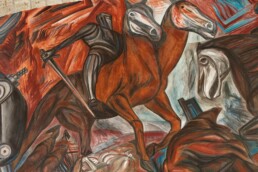CABEÇA FANTASMA E O RESTO DO CORPO TAMBÉM | SENTISTE A MINHA FALTA?
Miguel Bonneville
À superfície, parece existir uma tendência para criar uma separação drástica entre a sanidade e a demência, entre o espiritual e o patológico. cabeça fantasma – e o resto do corpo também parte da fricção entre essas categorias para investigar ideias em torno da santidade – e o que a distingue, ou aproxima, da loucura.
A partir da pergunta nuclear da série animais paisagens e santos – “o que é, ou pode ser, um santo hoje?” – esta conferência parte de uma necessidade de criar percursos pelas visões interiores de místicos, profetas e visionários que, ao longo dos séculos, desafiaram os limites do real. A figura do santo como guia para pensar formas de desvio, de atenção ao invisível e de resistência à normalização do pensamento.
Resiste-se à leitura da loucura como disfunção – assumindo-a, antes, como forma de conhecimento –, porque essa leitura é sintoma de um olhar que projecta a sua violência sobre quem que não se ajusta às constrições da normalidade. A loucura não é uma condição individual, mas uma resposta a uma sociedade que dilacerou os seus vínculos simbólicos com a terra e consigo mesma.
Os tempos são sempre de crise, as urgências em resolvê-las vão variando. Esta é mais uma forma de procurar repensar formas de relação com o mundo — possivelmente mais porosas, interdependentes, mais abertas à experiência do que não é obviamente visível.
E põe-se a hipótese de que talvez alguns santos, e as suas loucuras particulares, possam ajudar à desorganização de uma ordem que insiste em tornar-se – outra e cada vez mais – inflexível.
Bio
Miguel Bonneville
Porto, 1985. Artista transdisciplinar que cria obras autoficcionais, centradas na desconstrução e reconstrução da identidade, explorando questões de género, morte e espiritualidade. O seu trabalho combina múltiplas linguagens artísticas, incluindo escrita, música, vídeo e performance. Desde 2003, tem apresentado o seu trabalho nacional e internacionalmente, sobretudo os projectos seriados Family Project, Miguel Bonneville e A Importância de Ser.
Recebeu o Prémio da Rede Ex Aequo (2015) pelos espectáculos Medo e Feminismos, em colaboração com Maria Gil, e A Importância de Ser Simone de Beauvoir.
Estudou Interpretação na Academia Contemporânea do Espectáculo (2000-2003), tendo complementado os seus estudos com os cursos de: Artes Visuais na Fundação Calouste Gulbenkian/Programa Criatividade e Criação Artística (2006), Autobiografias, Histórias de Vida e Vidas de Artista no CIES-ISCTE (2008), Arquivo – Organização e Manutenção no Citeforma (2013), Cyborgs, Sexo e Sociedade na FCSH (2016), e Filosofia e Arte na Mute (2017), entre outros.
Recebeu bolsas da Fundação Calouste Gulbenkian, do Centro Nacional da Cultura – Jovens Criadores, da Câmara Municipal do Funchal – Bolsa de Criação Artística/Escrita e do programa Culture Moves Europe.
Fez parte da Direcção Artística do Teatro do Silêncio (2018-2023), e do núcleo de artistas representados pela Galeria 3+1 Arte Contemporânea (2009-2013) e pela estrutura de dança contemporânea Eira (2004-2006).
Realizou filmes e vídeos como Camera Obscura (2023), Um medo com duas grandes faces (2022), Traça (2016), A landscape of failure (2008), entre outros. E teve financiamento do Apoio à Escrita e Desenvolvimento de Obras Cinematográficas 2021 – ICA para desenvolver o argumento da sua ideia original para longa-metragem de ficção Paisagem com pássaros amarelos (2021-2023), com produção da Cedro Plátano.
Publicou os livros: Os diários de C.C. Rausch (Corpos Editora, 2006), Ensaios de santidade (Sr. Teste, 2021), O pessoal é político (Douda Correria, 2021), Livro do Daniel e outros textos (Urutau, 2024), e ainda as edições de artista Jérôme, Olivier et moi (Homesession, 2008), Notas de um primata suicida (2017), e, pelo Teatro do Silêncio, Dissecação de um cisne (2018), Lamento do ciborgue (2021), Recuperar o corpo (2021) e Câmara escura (2022).
Contribuiu com vários textos para as revistas portuguesas Flanzine, WrongWrong, Dobra, Cine Qua Non, e Faces de Eva, e ainda para a revista brasileira Periódicus, entre outras publicações.
Foi artista residente no Sítio das Artes, CAMJAP/Fundação Calouste Gulbenkian (Lisboa, 2007), Homesession (Barcelona, 2008), Mugatxoan/Fundação de Serralves (Porto, 2010), Festival Transeuropa2012 (Hildesheim, 2012), Arts Printing House (Vilnius, 2013), Arte y Desarrollo (Madrid, 2014), e La Box (Bourges, 2018), entre outros.
Ficha Técnica
Autoria e interpretação
Miguel Bonneville
Registos vídeo e fotográfico
Joana Linda
Assessoria de imprensa
Mafalda Guedes Vaz
Produção
Cristina Correia, Miguel Bonneville
Co-Produção
Festival Temps d’Image
Apoio
Direcção–Geral das Artes, Fundação GDA
CABEÇA FANTASMA E O RESTO DO CORPO TAMBÉM | DID YOU MISS ME?
Miguel Bonneville
On the surface, there seems to be a tendency to create a drastic separation between sanity and insanity, between the spiritual and the pathological. Ghost Head – and the rest of the body also draws on the friction between these categories to investigate ideas surrounding holiness – and what distinguishes it from, or brings it closer to, madness.
Based on the core question of the series animals landscapes and saints – “what is, or can be, a saint today?” – this conference stems from a need to create paths through the inner visions of mystics, prophets, and visionaries who, over the centuries, have challenged the limits of reality. The figure of the saint as a guide for thinking about forms of deviation, of attention to the invisible, and of resistance to the normalization of thought. It resists the interpretation of madness as dysfunction – assuming it, rather, as a form of knowledge – because this interpretation is symptomatic of a view that projects its violence onto those who do not conform to the constraints of normality. Madness is not an individual condition, but a response to a society that has severed its symbolic ties with the earth and with itself.
Times are always times of crisis, but the urgency to resolve them varies. This is yet another way of rethinking our relationship with the world—perhaps in ways that are more porous, interdependent, and open to experiences that are not immediately visible.
And the hypothesis is put forward that perhaps some saints, and their particular follies, can help to disrupt an order that insists on becoming—ever more so—inflexible.
Miguel Bonneville (Porto, 1985.)
Transdisciplinary artist who creates autofictional works focused on the deconstruction and reconstruction of identity, exploring issues of gender, death, and spirituality. His work combines multiple artistic languages, including writing, music, video, and performance.
Since 2003, he has presented his work nationally and internationally,
particularly the serial projects Family Project, Miguel Bonneville, and A
Importância de Ser. Bonneville received the Rede Ex Aequo Award (2015) for the
shows Medo e Feminismos, in collaboration with Maria Gil, and A Importância
de Ser Simone de Beauvoir.
Studied Acting at the Academia Contemporânea do Espectáculo (2000-2003), complementing his studies with courses in: Visual Arts at the Calouste Gulbenkian Foundation/Creativity and Artistic Creation Program (2006), Autobiographies, Life Stories, and Artists’ Lives at CIES-ISCTE (2008), Archiving – Organization and Maintenance at Citeforma (2013), Cyborgs, Sex, and Society at FCSH (2016), and Philosophy and Art at Mute (2017), among others.
He has received grants from the Calouste Gulbenkian Foundation, the National Culture Center – Young Creators, the Funchal City Council – Artistic Creation/Writing Grant, and the Culture Moves Europe program.
He was part of the Artistic Direction of Teatro do Silêncio (2018- 2023), and of the group of artists represented by Galeria 3+1 Arte Contemporânea (2009-2013) and by the contemporary dance structure Eira (2004-2006).
He has made films and videos such as Camera Obscura (2023), Um medo com duas grandes faces (2022), Traça (2016), A landscape of failure (2008), among others. He received funding from the 2021 Support for Writing and Development of Cinematographic Works – ICA to develop the script for his original idea for a feature film, Paisagem com pássaros amarelos (Landscape with Yellow Birds) (2021-2023), produced by Cedro Plátano.
He has published the books: Os diários de C.C. Rausch (Corpos Editora, 2006), Ensaios de santidade (Sr. Teste, 2021), O pessoal é político (Douda Correria, 2021), Livro do Daniel e outros textos (Urutau, 2024), as well as the artist’s editions Jérôme, Olivier et moi (Homesession, 2008), Notas de um primata suicida (Notes of a suicidal primate) (2017), and, for Teatro do Silêncio, Dissecação de um cisne (Dissection of a swan) (2018), Lamento do ciborgue (Lament of the cyborg) (2021), Recuperar o corpo (Recovering the body) (2021), and Câmara escura (Darkroom) (2022).
He has contributed several texts to the Portuguese magazines Flanzine, WrongWrong, Dobra, Cine Qua Non, and Faces de Eva, as well as to the Brazilian magazine Periódicus, among other publications.
He was artist-in-residence at Sítio das Artes, CAMJAP/Calouste Gulbenkian Foundation (Lisbon, 2007), Homesession (Barcelona, 2008), Mugatxoan/Serralves Foundation (Porto, 2010), Festival Transeuropa2012 (Hildesheim, 2012), Arts Printing House (Vilnius, 2013), Arte y Desarrollo (Madrid, 2014), and La Box (Bourges, 2018), among others.
Credits
Author and performer
Miguel Bonneville
Video and photographic recording
Joana Linda
Press relations
Mafalda Guedes Vaz
Production
Cristina Correia, Miguel Bonneville
Co-Production
Festival Temps d’Images
Support
Direcção–Geral das Artes, Fundação GDA



